Organizational Culture and Workforce Motivation: A Report
VerifiedAdded on 2022/09/16
|8
|1868
|45
Report
AI Summary
This report examines the intricate relationship between organizational culture and workforce motivation, exploring various types of organizational cultures, including power, role, task, and person cultures, and their impact on employee behavior. It delves into the importance of organizational culture, its positive and negative impacts, and provides a detailed analysis of Google's organizational culture as a case study. The report further explores organizational power, its types, and its influence on organizational behavior, including a discussion of organizational politics. It then investigates the concept of motivation, differentiating between intrinsic and extrinsic motivation, and examines how Google utilizes these motivational strategies. Content theories like Maslow's hierarchy of needs and process theories such as Vroom's expectancy theory are discussed, along with their application in Google's approach to employee management. The report concludes by highlighting the significance of motivation in enhancing employee productivity and the role of inspirational leadership, as exemplified by Google's practices, in creating a motivated and engaged workforce. The report emphasizes the importance of creating a comfortable and productive work environment.
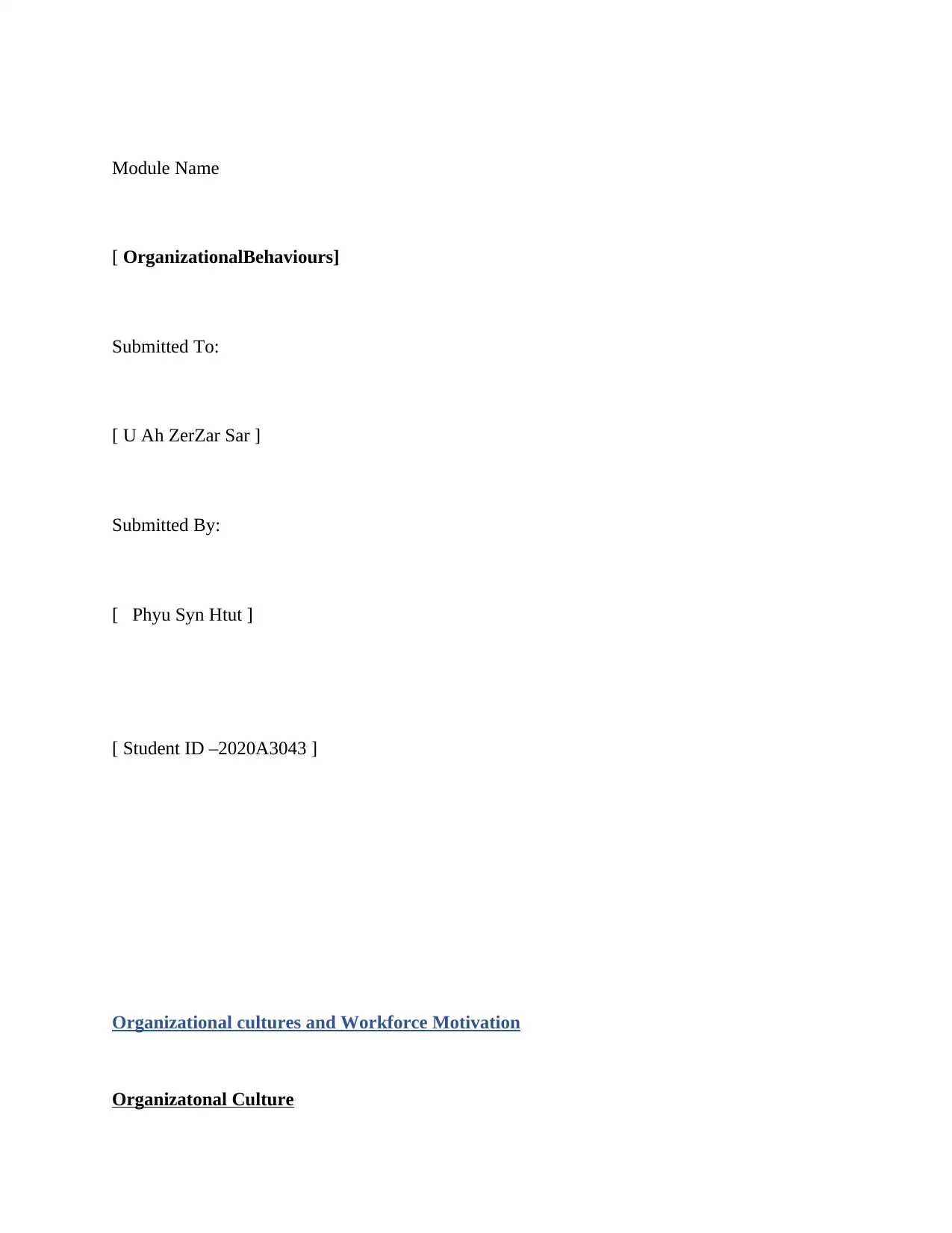
Module Name
[ OrganizationalBehaviours]
Submitted To:
[ U Ah ZerZar Sar ]
Submitted By:
[ Phyu Syn Htut ]
[ Student ID –2020A3043 ]
Organizational cultures and Workforce Motivation
Organizatonal Culture
[ OrganizationalBehaviours]
Submitted To:
[ U Ah ZerZar Sar ]
Submitted By:
[ Phyu Syn Htut ]
[ Student ID –2020A3043 ]
Organizational cultures and Workforce Motivation
Organizatonal Culture
Paraphrase This Document
Need a fresh take? Get an instant paraphrase of this document with our AI Paraphraser
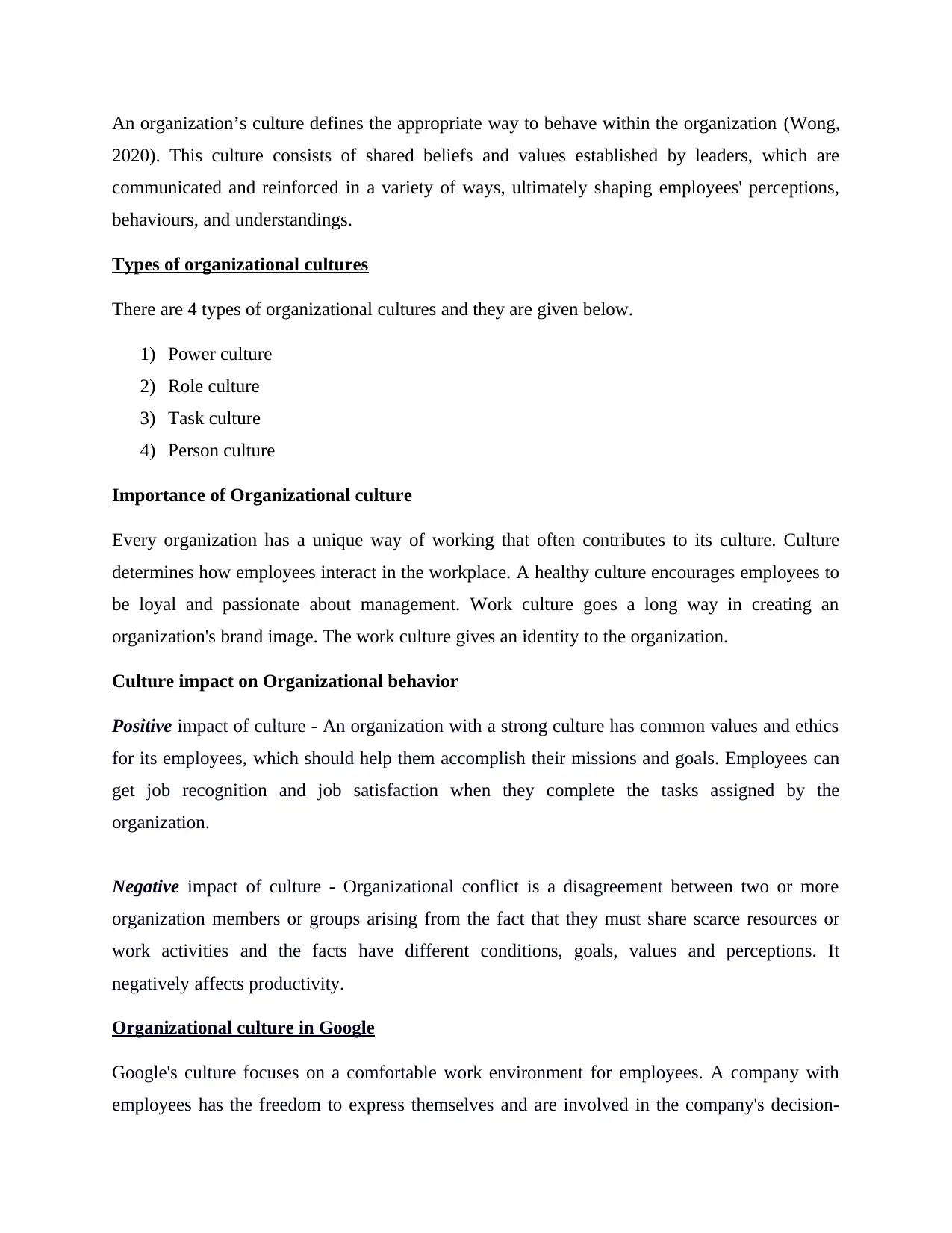
An organization’s culture defines the appropriate way to behave within the organization (Wong,
2020). This culture consists of shared beliefs and values established by leaders, which are
communicated and reinforced in a variety of ways, ultimately shaping employees' perceptions,
behaviours, and understandings.
Types of organizational cultures
There are 4 types of organizational cultures and they are given below.
1) Power culture
2) Role culture
3) Task culture
4) Person culture
Importance of Organizational culture
Every organization has a unique way of working that often contributes to its culture. Culture
determines how employees interact in the workplace. A healthy culture encourages employees to
be loyal and passionate about management. Work culture goes a long way in creating an
organization's brand image. The work culture gives an identity to the organization.
Culture impact on Organizational behavior
Positive impact of culture - An organization with a strong culture has common values and ethics
for its employees, which should help them accomplish their missions and goals. Employees can
get job recognition and job satisfaction when they complete the tasks assigned by the
organization.
Negative impact of culture - Organizational conflict is a disagreement between two or more
organization members or groups arising from the fact that they must share scarce resources or
work activities and the facts have different conditions, goals, values and perceptions. It
negatively affects productivity.
Organizational culture in Google
Google's culture focuses on a comfortable work environment for employees. A company with
employees has the freedom to express themselves and are involved in the company's decision-
2020). This culture consists of shared beliefs and values established by leaders, which are
communicated and reinforced in a variety of ways, ultimately shaping employees' perceptions,
behaviours, and understandings.
Types of organizational cultures
There are 4 types of organizational cultures and they are given below.
1) Power culture
2) Role culture
3) Task culture
4) Person culture
Importance of Organizational culture
Every organization has a unique way of working that often contributes to its culture. Culture
determines how employees interact in the workplace. A healthy culture encourages employees to
be loyal and passionate about management. Work culture goes a long way in creating an
organization's brand image. The work culture gives an identity to the organization.
Culture impact on Organizational behavior
Positive impact of culture - An organization with a strong culture has common values and ethics
for its employees, which should help them accomplish their missions and goals. Employees can
get job recognition and job satisfaction when they complete the tasks assigned by the
organization.
Negative impact of culture - Organizational conflict is a disagreement between two or more
organization members or groups arising from the fact that they must share scarce resources or
work activities and the facts have different conditions, goals, values and perceptions. It
negatively affects productivity.
Organizational culture in Google
Google's culture focuses on a comfortable work environment for employees. A company with
employees has the freedom to express themselves and are involved in the company's decision-
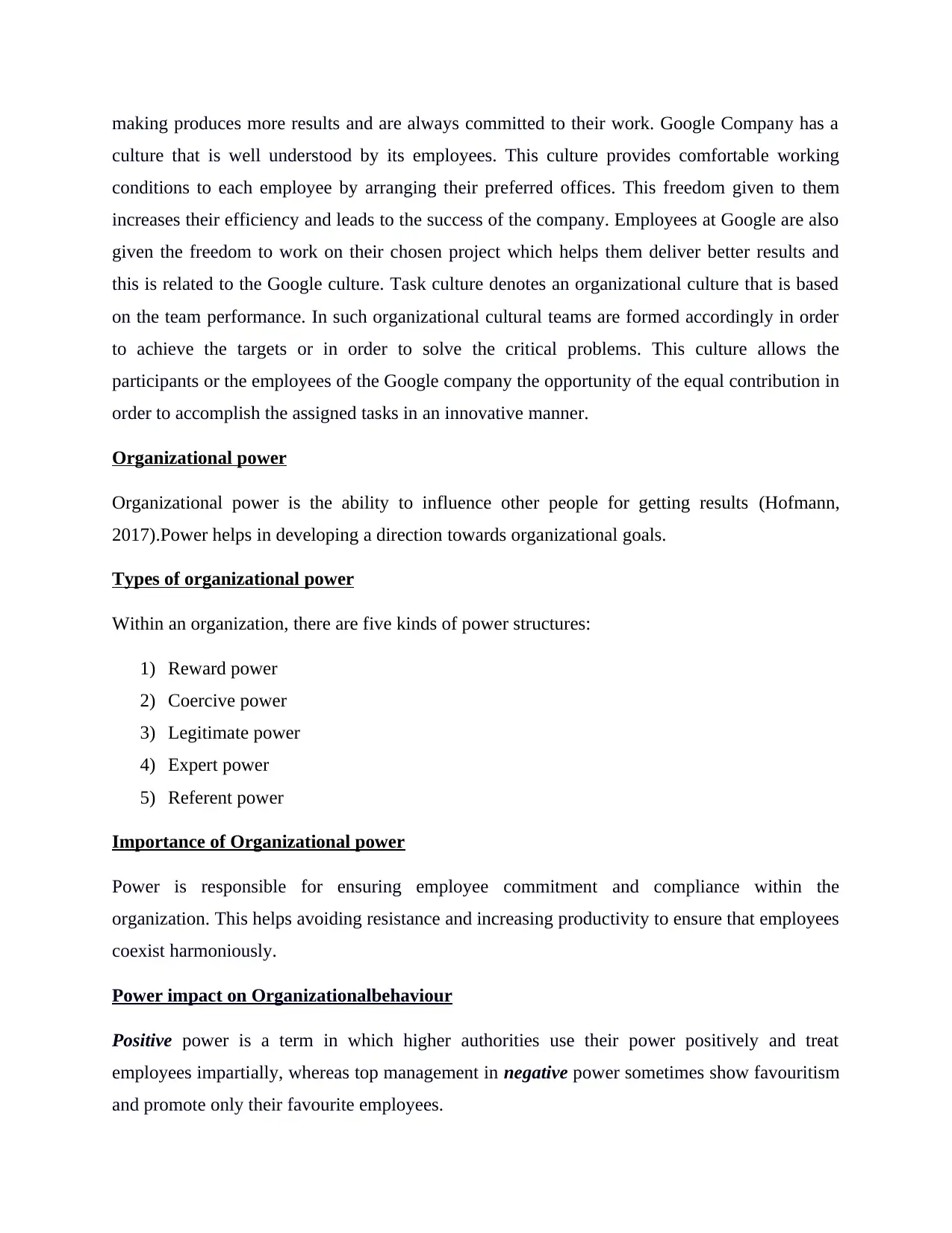
making produces more results and are always committed to their work. Google Company has a
culture that is well understood by its employees. This culture provides comfortable working
conditions to each employee by arranging their preferred offices. This freedom given to them
increases their efficiency and leads to the success of the company. Employees at Google are also
given the freedom to work on their chosen project which helps them deliver better results and
this is related to the Google culture. Task culture denotes an organizational culture that is based
on the team performance. In such organizational cultural teams are formed accordingly in order
to achieve the targets or in order to solve the critical problems. This culture allows the
participants or the employees of the Google company the opportunity of the equal contribution in
order to accomplish the assigned tasks in an innovative manner.
Organizational power
Organizational power is the ability to influence other people for getting results (Hofmann,
2017).Power helps in developing a direction towards organizational goals.
Types of organizational power
Within an organization, there are five kinds of power structures:
1) Reward power
2) Coercive power
3) Legitimate power
4) Expert power
5) Referent power
Importance of Organizational power
Power is responsible for ensuring employee commitment and compliance within the
organization. This helps avoiding resistance and increasing productivity to ensure that employees
coexist harmoniously.
Power impact on Organizationalbehaviour
Positive power is a term in which higher authorities use their power positively and treat
employees impartially, whereas top management in negative power sometimes show favouritism
and promote only their favourite employees.
culture that is well understood by its employees. This culture provides comfortable working
conditions to each employee by arranging their preferred offices. This freedom given to them
increases their efficiency and leads to the success of the company. Employees at Google are also
given the freedom to work on their chosen project which helps them deliver better results and
this is related to the Google culture. Task culture denotes an organizational culture that is based
on the team performance. In such organizational cultural teams are formed accordingly in order
to achieve the targets or in order to solve the critical problems. This culture allows the
participants or the employees of the Google company the opportunity of the equal contribution in
order to accomplish the assigned tasks in an innovative manner.
Organizational power
Organizational power is the ability to influence other people for getting results (Hofmann,
2017).Power helps in developing a direction towards organizational goals.
Types of organizational power
Within an organization, there are five kinds of power structures:
1) Reward power
2) Coercive power
3) Legitimate power
4) Expert power
5) Referent power
Importance of Organizational power
Power is responsible for ensuring employee commitment and compliance within the
organization. This helps avoiding resistance and increasing productivity to ensure that employees
coexist harmoniously.
Power impact on Organizationalbehaviour
Positive power is a term in which higher authorities use their power positively and treat
employees impartially, whereas top management in negative power sometimes show favouritism
and promote only their favourite employees.
⊘ This is a preview!⊘
Do you want full access?
Subscribe today to unlock all pages.

Trusted by 1+ million students worldwide
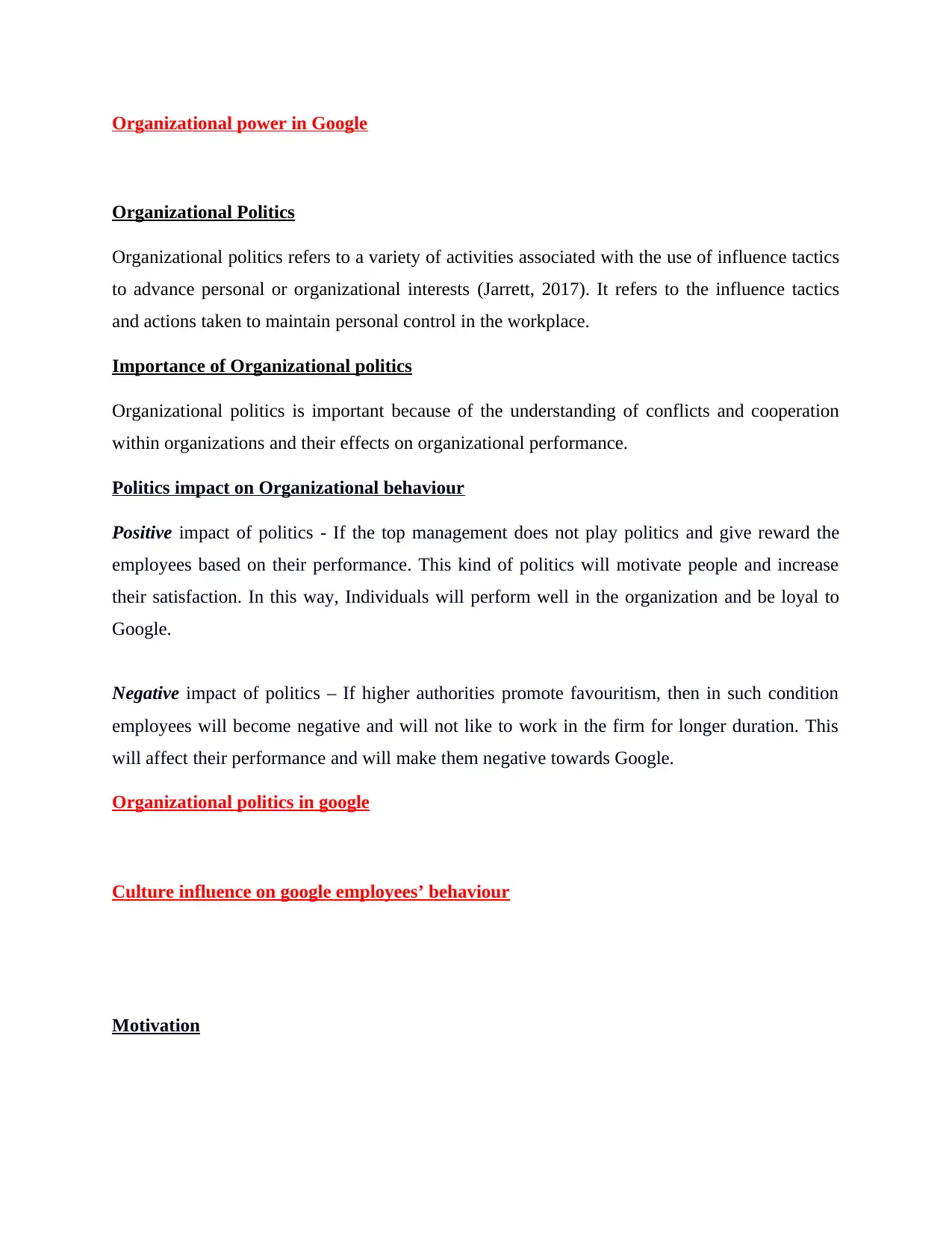
Organizational power in Google
Organizational Politics
Organizational politics refers to a variety of activities associated with the use of influence tactics
to advance personal or organizational interests (Jarrett, 2017). It refers to the influence tactics
and actions taken to maintain personal control in the workplace.
Importance of Organizational politics
Organizational politics is important because of the understanding of conflicts and cooperation
within organizations and their effects on organizational performance.
Politics impact on Organizational behaviour
Positive impact of politics - If the top management does not play politics and give reward the
employees based on their performance. This kind of politics will motivate people and increase
their satisfaction. In this way, Individuals will perform well in the organization and be loyal to
Google.
Negative impact of politics – If higher authorities promote favouritism, then in such condition
employees will become negative and will not like to work in the firm for longer duration. This
will affect their performance and will make them negative towards Google.
Organizational politics in google
Culture influence on google employees’ behaviour
Motivation
Organizational Politics
Organizational politics refers to a variety of activities associated with the use of influence tactics
to advance personal or organizational interests (Jarrett, 2017). It refers to the influence tactics
and actions taken to maintain personal control in the workplace.
Importance of Organizational politics
Organizational politics is important because of the understanding of conflicts and cooperation
within organizations and their effects on organizational performance.
Politics impact on Organizational behaviour
Positive impact of politics - If the top management does not play politics and give reward the
employees based on their performance. This kind of politics will motivate people and increase
their satisfaction. In this way, Individuals will perform well in the organization and be loyal to
Google.
Negative impact of politics – If higher authorities promote favouritism, then in such condition
employees will become negative and will not like to work in the firm for longer duration. This
will affect their performance and will make them negative towards Google.
Organizational politics in google
Culture influence on google employees’ behaviour
Motivation
Paraphrase This Document
Need a fresh take? Get an instant paraphrase of this document with our AI Paraphraser
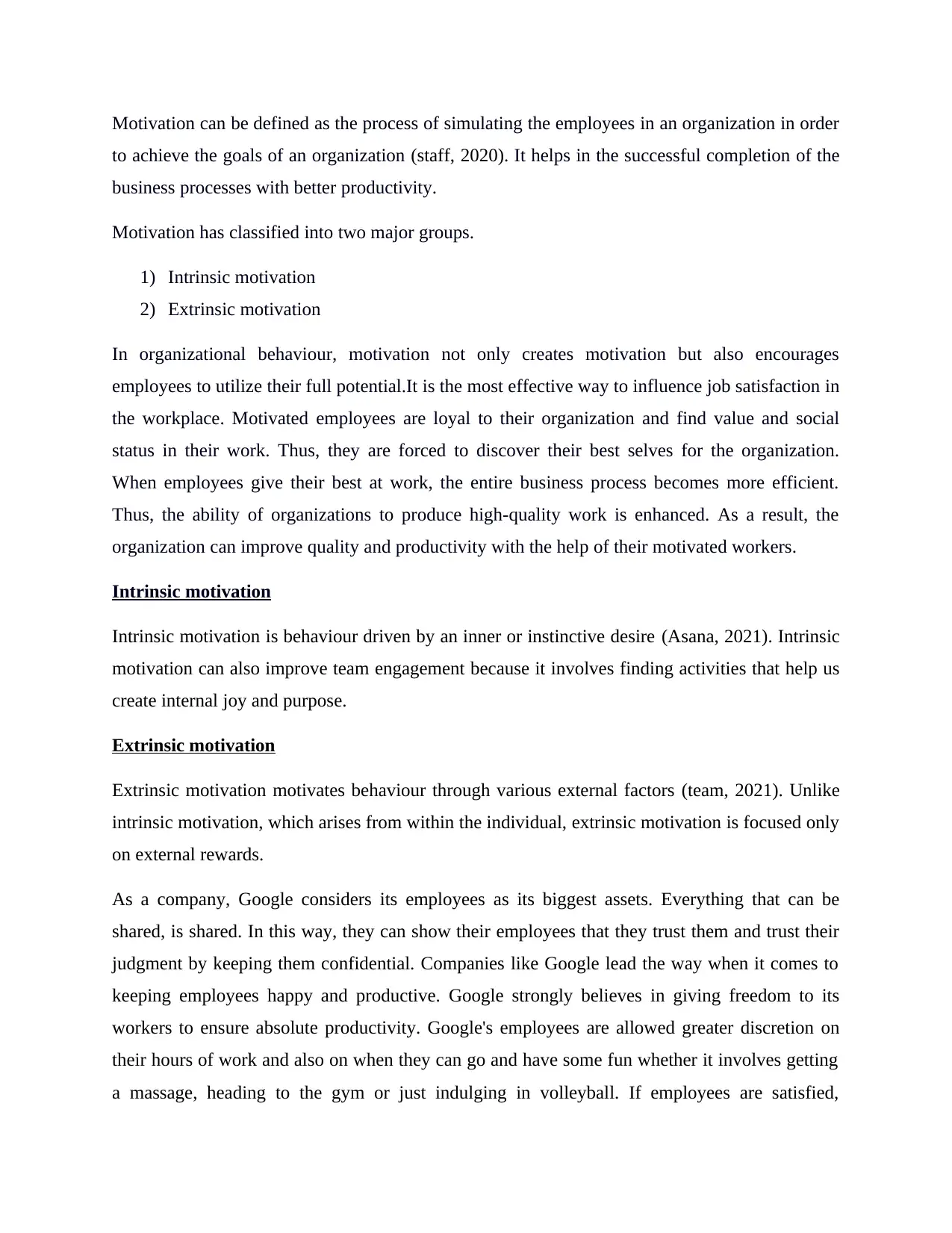
Motivation can be defined as the process of simulating the employees in an organization in order
to achieve the goals of an organization (staff, 2020). It helps in the successful completion of the
business processes with better productivity.
Motivation has classified into two major groups.
1) Intrinsic motivation
2) Extrinsic motivation
In organizational behaviour, motivation not only creates motivation but also encourages
employees to utilize their full potential.It is the most effective way to influence job satisfaction in
the workplace. Motivated employees are loyal to their organization and find value and social
status in their work. Thus, they are forced to discover their best selves for the organization.
When employees give their best at work, the entire business process becomes more efficient.
Thus, the ability of organizations to produce high-quality work is enhanced. As a result, the
organization can improve quality and productivity with the help of their motivated workers.
Intrinsic motivation
Intrinsic motivation is behaviour driven by an inner or instinctive desire (Asana, 2021). Intrinsic
motivation can also improve team engagement because it involves finding activities that help us
create internal joy and purpose.
Extrinsic motivation
Extrinsic motivation motivates behaviour through various external factors (team, 2021). Unlike
intrinsic motivation, which arises from within the individual, extrinsic motivation is focused only
on external rewards.
As a company, Google considers its employees as its biggest assets. Everything that can be
shared, is shared. In this way, they can show their employees that they trust them and trust their
judgment by keeping them confidential. Companies like Google lead the way when it comes to
keeping employees happy and productive. Google strongly believes in giving freedom to its
workers to ensure absolute productivity. Google's employees are allowed greater discretion on
their hours of work and also on when they can go and have some fun whether it involves getting
a massage, heading to the gym or just indulging in volleyball. If employees are satisfied,
to achieve the goals of an organization (staff, 2020). It helps in the successful completion of the
business processes with better productivity.
Motivation has classified into two major groups.
1) Intrinsic motivation
2) Extrinsic motivation
In organizational behaviour, motivation not only creates motivation but also encourages
employees to utilize their full potential.It is the most effective way to influence job satisfaction in
the workplace. Motivated employees are loyal to their organization and find value and social
status in their work. Thus, they are forced to discover their best selves for the organization.
When employees give their best at work, the entire business process becomes more efficient.
Thus, the ability of organizations to produce high-quality work is enhanced. As a result, the
organization can improve quality and productivity with the help of their motivated workers.
Intrinsic motivation
Intrinsic motivation is behaviour driven by an inner or instinctive desire (Asana, 2021). Intrinsic
motivation can also improve team engagement because it involves finding activities that help us
create internal joy and purpose.
Extrinsic motivation
Extrinsic motivation motivates behaviour through various external factors (team, 2021). Unlike
intrinsic motivation, which arises from within the individual, extrinsic motivation is focused only
on external rewards.
As a company, Google considers its employees as its biggest assets. Everything that can be
shared, is shared. In this way, they can show their employees that they trust them and trust their
judgment by keeping them confidential. Companies like Google lead the way when it comes to
keeping employees happy and productive. Google strongly believes in giving freedom to its
workers to ensure absolute productivity. Google's employees are allowed greater discretion on
their hours of work and also on when they can go and have some fun whether it involves getting
a massage, heading to the gym or just indulging in volleyball. If employees are satisfied,
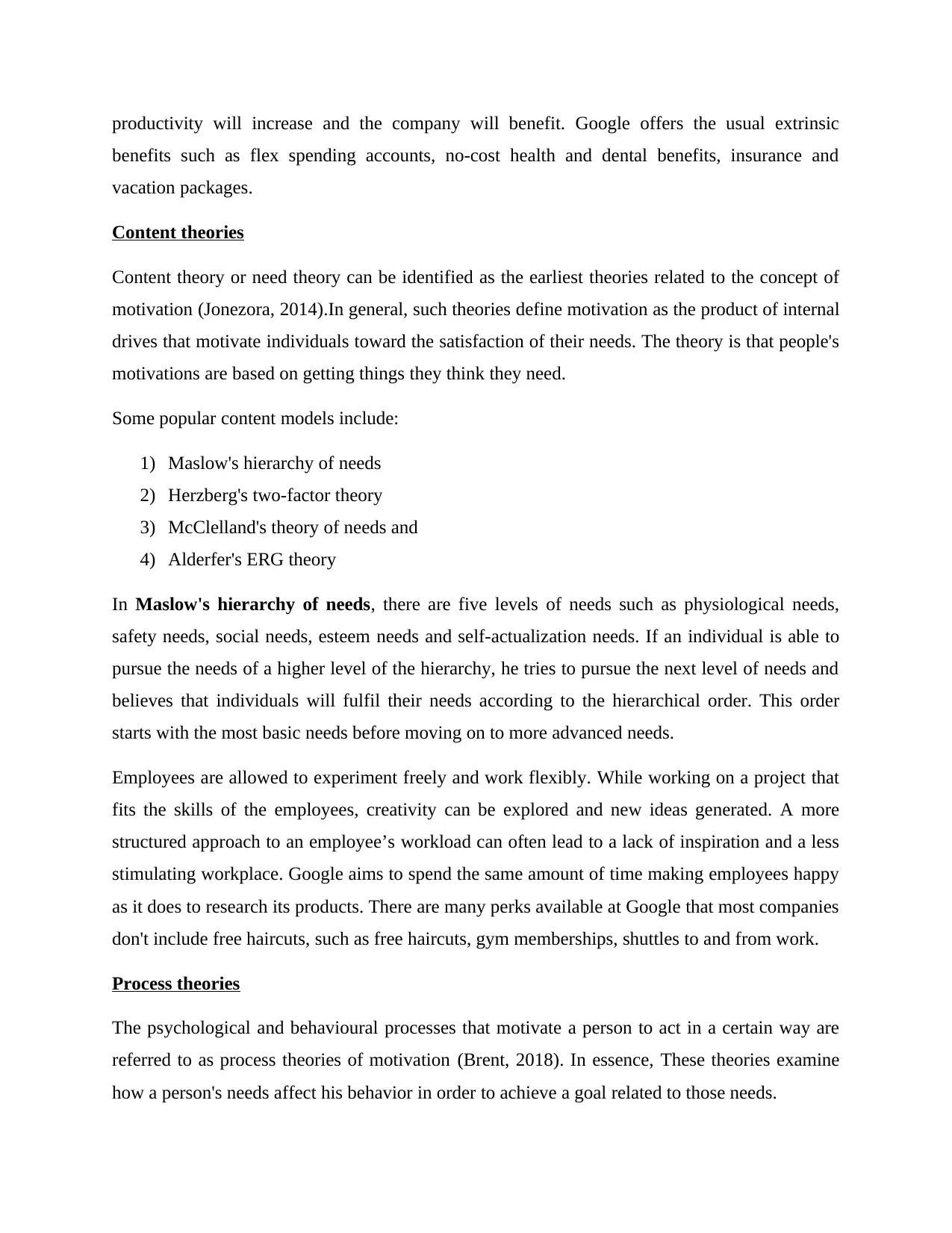
productivity will increase and the company will benefit. Google offers the usual extrinsic
benefits such as flex spending accounts, no-cost health and dental benefits, insurance and
vacation packages.
Content theories
Content theory or need theory can be identified as the earliest theories related to the concept of
motivation (Jonezora, 2014).In general, such theories define motivation as the product of internal
drives that motivate individuals toward the satisfaction of their needs. The theory is that people's
motivations are based on getting things they think they need.
Some popular content models include:
1) Maslow's hierarchy of needs
2) Herzberg's two-factor theory
3) McClelland's theory of needs and
4) Alderfer's ERG theory
In Maslow's hierarchy of needs, there are five levels of needs such as physiological needs,
safety needs, social needs, esteem needs and self-actualization needs. If an individual is able to
pursue the needs of a higher level of the hierarchy, he tries to pursue the next level of needs and
believes that individuals will fulfil their needs according to the hierarchical order. This order
starts with the most basic needs before moving on to more advanced needs.
Employees are allowed to experiment freely and work flexibly. While working on a project that
fits the skills of the employees, creativity can be explored and new ideas generated. A more
structured approach to an employee’s workload can often lead to a lack of inspiration and a less
stimulating workplace. Google aims to spend the same amount of time making employees happy
as it does to research its products. There are many perks available at Google that most companies
don't include free haircuts, such as free haircuts, gym memberships, shuttles to and from work.
Process theories
The psychological and behavioural processes that motivate a person to act in a certain way are
referred to as process theories of motivation (Brent, 2018). In essence, These theories examine
how a person's needs affect his behavior in order to achieve a goal related to those needs.
benefits such as flex spending accounts, no-cost health and dental benefits, insurance and
vacation packages.
Content theories
Content theory or need theory can be identified as the earliest theories related to the concept of
motivation (Jonezora, 2014).In general, such theories define motivation as the product of internal
drives that motivate individuals toward the satisfaction of their needs. The theory is that people's
motivations are based on getting things they think they need.
Some popular content models include:
1) Maslow's hierarchy of needs
2) Herzberg's two-factor theory
3) McClelland's theory of needs and
4) Alderfer's ERG theory
In Maslow's hierarchy of needs, there are five levels of needs such as physiological needs,
safety needs, social needs, esteem needs and self-actualization needs. If an individual is able to
pursue the needs of a higher level of the hierarchy, he tries to pursue the next level of needs and
believes that individuals will fulfil their needs according to the hierarchical order. This order
starts with the most basic needs before moving on to more advanced needs.
Employees are allowed to experiment freely and work flexibly. While working on a project that
fits the skills of the employees, creativity can be explored and new ideas generated. A more
structured approach to an employee’s workload can often lead to a lack of inspiration and a less
stimulating workplace. Google aims to spend the same amount of time making employees happy
as it does to research its products. There are many perks available at Google that most companies
don't include free haircuts, such as free haircuts, gym memberships, shuttles to and from work.
Process theories
The psychological and behavioural processes that motivate a person to act in a certain way are
referred to as process theories of motivation (Brent, 2018). In essence, These theories examine
how a person's needs affect his behavior in order to achieve a goal related to those needs.
⊘ This is a preview!⊘
Do you want full access?
Subscribe today to unlock all pages.

Trusted by 1+ million students worldwide
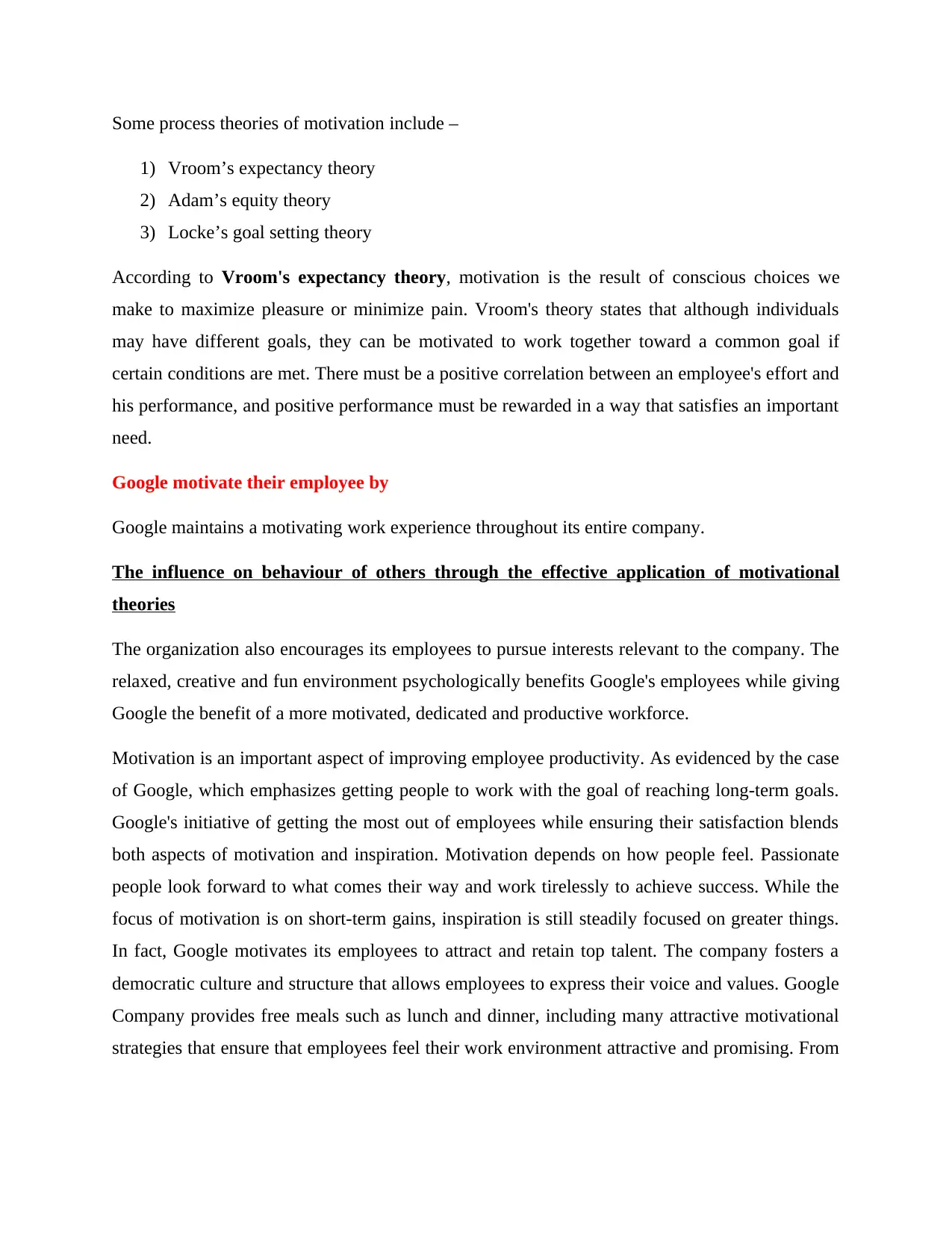
Some process theories of motivation include –
1) Vroom’s expectancy theory
2) Adam’s equity theory
3) Locke’s goal setting theory
According to Vroom's expectancy theory, motivation is the result of conscious choices we
make to maximize pleasure or minimize pain. Vroom's theory states that although individuals
may have different goals, they can be motivated to work together toward a common goal if
certain conditions are met. There must be a positive correlation between an employee's effort and
his performance, and positive performance must be rewarded in a way that satisfies an important
need.
Google motivate their employee by
Google maintains a motivating work experience throughout its entire company.
The influence on behaviour of others through the effective application of motivational
theories
The organization also encourages its employees to pursue interests relevant to the company. The
relaxed, creative and fun environment psychologically benefits Google's employees while giving
Google the benefit of a more motivated, dedicated and productive workforce.
Motivation is an important aspect of improving employee productivity. As evidenced by the case
of Google, which emphasizes getting people to work with the goal of reaching long-term goals.
Google's initiative of getting the most out of employees while ensuring their satisfaction blends
both aspects of motivation and inspiration. Motivation depends on how people feel. Passionate
people look forward to what comes their way and work tirelessly to achieve success. While the
focus of motivation is on short-term gains, inspiration is still steadily focused on greater things.
In fact, Google motivates its employees to attract and retain top talent. The company fosters a
democratic culture and structure that allows employees to express their voice and values. Google
Company provides free meals such as lunch and dinner, including many attractive motivational
strategies that ensure that employees feel their work environment attractive and promising. From
1) Vroom’s expectancy theory
2) Adam’s equity theory
3) Locke’s goal setting theory
According to Vroom's expectancy theory, motivation is the result of conscious choices we
make to maximize pleasure or minimize pain. Vroom's theory states that although individuals
may have different goals, they can be motivated to work together toward a common goal if
certain conditions are met. There must be a positive correlation between an employee's effort and
his performance, and positive performance must be rewarded in a way that satisfies an important
need.
Google motivate their employee by
Google maintains a motivating work experience throughout its entire company.
The influence on behaviour of others through the effective application of motivational
theories
The organization also encourages its employees to pursue interests relevant to the company. The
relaxed, creative and fun environment psychologically benefits Google's employees while giving
Google the benefit of a more motivated, dedicated and productive workforce.
Motivation is an important aspect of improving employee productivity. As evidenced by the case
of Google, which emphasizes getting people to work with the goal of reaching long-term goals.
Google's initiative of getting the most out of employees while ensuring their satisfaction blends
both aspects of motivation and inspiration. Motivation depends on how people feel. Passionate
people look forward to what comes their way and work tirelessly to achieve success. While the
focus of motivation is on short-term gains, inspiration is still steadily focused on greater things.
In fact, Google motivates its employees to attract and retain top talent. The company fosters a
democratic culture and structure that allows employees to express their voice and values. Google
Company provides free meals such as lunch and dinner, including many attractive motivational
strategies that ensure that employees feel their work environment attractive and promising. From
Paraphrase This Document
Need a fresh take? Get an instant paraphrase of this document with our AI Paraphraser

the perspectives of the range of motivation initiatives adopted by Google Company, motivation
involves the control of people's beliefs, steps, and actions.
involves the control of people's beliefs, steps, and actions.
1 out of 8
Related Documents
Your All-in-One AI-Powered Toolkit for Academic Success.
+13062052269
info@desklib.com
Available 24*7 on WhatsApp / Email
![[object Object]](/_next/static/media/star-bottom.7253800d.svg)
Unlock your academic potential
Copyright © 2020–2025 A2Z Services. All Rights Reserved. Developed and managed by ZUCOL.




